Terrain-Based High-Resolution Microclimate Modeling for Cold-Air-Pool-Induced Frost Risk Assessment in Karst Depressions
Abstract
1. Introduction
2. Materials and Methods
2.1. Topographical Database Methodology
2.2. DSM-Based Model Methodology
2.3. Meteorological Data Collection Methodology
2.4. Thermal Camera Recording Methodology
2.5. Delimitation of the Research Area
3. Results
3.1. Land-Cover-Based Analysis of the Orthomosaic Images of the Study Area
3.2. Micro-Topographic Analysis of the Research Territory
3.3. The Results of the Specific Models Derived from the GIS Database
3.3.1. Sky-View Analysis for the Mohos Sinkhole
3.3.2. Analysis of Wind Exposition Index for the Mohos Sinkhole
3.3.3. Analysis of Cold Air Flow Index for the Mohos Sinkhole
Control Measurements
3.3.4. Analysis Based on Diurnal Anisotropic Heat Model in the Mohos Sinkhole
Thermal Camera Analysis of the Location of the Cold-Air-Pool During the Irradiation Period
3.4. Recorded CAP Cases
4. Discussion
5. Conclusions
Author Contributions
Funding
Data Availability Statement
Acknowledgments
Conflicts of Interest
Abbreviations
| MS | Mohos sinkhole |
| K-2 | control measurement point (ridge of the basin) |
| K-3 | control measurement point (1st outflow of the MS) |
| K-9 | Control measurement point (peak) |
| DEM | Digital Elevation Model |
| DSM | Digital Surface Model |
| DTR | Diurnal Temperature Range |
| T | Temperature |
| T(s) | Soil Temperature |
| T-max. | Maximum Temperature |
| T-min. | Minimum temperature |
| CAP | Cold-Air-Pool |
| GIS | Geographic Information System |
| fv | Sky-view Factor |
| Alt. | Altitude above sea-level |
| N | North |
| E | East |
| S | South |
| W | West |
| Avg. | average |
| RGB | Red–Green–Blue composite picture |
| R2 | Level of co-variance |
| ICR max. | Maximum hourly cooling rate |
Appendix A
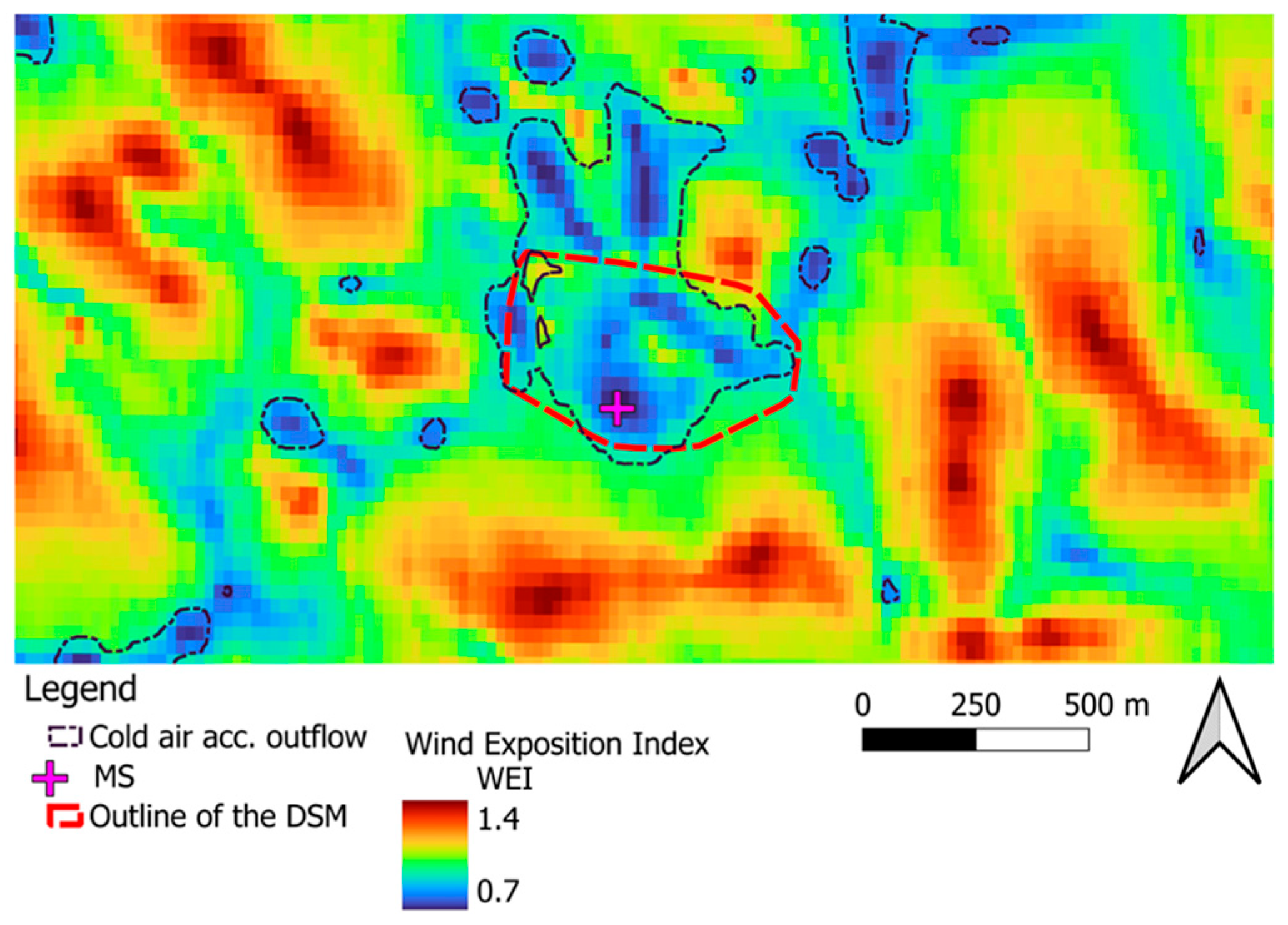
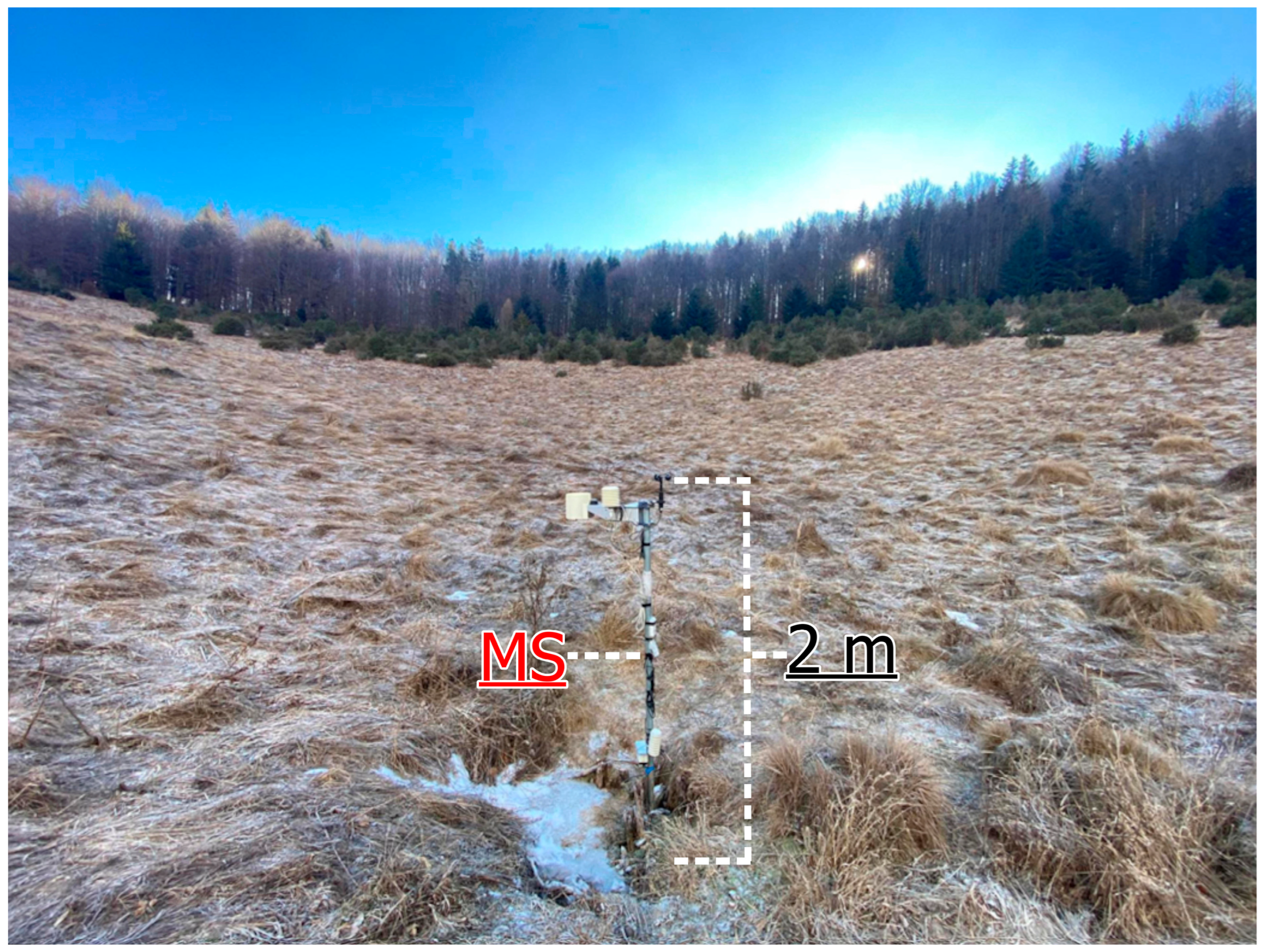
| Class Distribution of the Investigated Area | |||
|---|---|---|---|
| Thematic Image Class | Number of Samples | Percent (%) | Area (m2) |
| Pines | 9,919,913 | 1.99% | 5,576,619 m2 |
| Snow | 777,260 | 0.16% | 436,948 m2 |
| Junipers | 203,564,125 | 40.89% | 114,436,443 m2 |
| Lithotypes | 224,331,052 | 45.07% | 126,110,864 m2 |
| Beech communities | 59,193,510 | 11.89% | 33,276,466 m2 |
| Total | 497,785,860 | 100.00% | 279,837,340 m2 |
| Model | Parameters | ||||
|---|---|---|---|---|---|
| Sky-View Factor | Name | Type | Identifier | Description (and Constraints) | |
| Input | Elevation | grid, input | DEM |
| |
| Output | Visible Sky | grid, output | VISIBLE | The unobstructed hemisphere given as percentage. | |
| Sky-View Factor | grid, output | SVF |
| ||
| Sky-View Factor (Simplified) | grid, output, optional | SIMPLE |
| ||
| Terrain View Factor | grid, output, optional | TERRAIN |
| ||
| Average View Distance | grid, output, optional | DISTANCE | Average distance to horizon. | ||
| Options | Grid System | grid system | PARAMETERS_GRID_SYSTEM |
| |
| Maximum Search Radius | floating point number | RADIUS | The maximum search radius [map units]. This value is ignored if set to zero. (10,000) | ||
| Number of Sectors | integer number | NDIRS |
| ||
| Method | choice | METHOD |
| ||
| Multi Scale Factor | floating point number | DLEVEL | - | ||
| Wind Exposition Index | Input | Elevation | Grid (input) | DEM |
|
| Output | Wind Exposition | Grid (output) | EXPOSITION |
| |
| Options | Search Distance [km] | Floating point | MAXDIST |
| |
| Angular Step Size (Degree) | Floating point | STEP |
| ||
| Old Version | Boolean | OLDVER | use old version for constant wind direction (no acceleration and averaging option) | ||
| Acceleration | Floating point | ACCEL |
| ||
| Elevation Averaging | Boolean | PYRAMIDS | use more averaged elevations when looking at increasing distances | ||
| Cold Air Flow | Input | Elevation | Grid, input | DEM |
|
| Production | Grid, input, optional | PRODUCTION | Rate of cold air production [m/h]. | ||
| Surface Friction Coefficient | Grid, input, optional | FRICTION | Surface friction coefficient. (1) | ||
| Output | Cold Air Height | Grid, output | AIR |
| |
| Velocity | Grid, output, optional | VELOCITY |
| ||
| Options | Grid System | Grid system | PARAMETERS_GRID_SYSTEM |
| |
| Default | Floating point | PRODUCTION_DEFAULT | default value if no grid has been selected | ||
| Default | Floating point | FRICTION_DEFAULT | default value if no grid has been selected | ||
| Reset | Boolean | RESET |
| ||
| Simulation Time [h] | Floating point | TIME_STOP | Simulation time in hours. (6 h) | ||
| Map Update Frequency [min] | Floating point | TIME_UPDATE |
| ||
| Edge | Choice | EDGE |
| ||
| Time Step Adjustment | Floating point | DELAY | Choosing a lower value will result in better numerical precision but also in a longer calculation time. (0.5) | ||
| Surrounding Air Temperature | Floating point | T_AIR | Surrounding air temperature [degree Celsius]. (15 °C) | ||
| Cold Air Temperature | Floating point | T_AIR_COLD | Cold air temperature [degree Celsius]. (0 °C) | ||
| Diurnal Anisotrpic Heat | Input | Elevation | Grid (input) | DEM |
|
| Output | Diurnal Anisotropic Heating | Grid (output) | DAH |
| |
| Options | Grid System | Grid system | PARAMETERS_GRID_SYSTEM |
| |
| Alpha Max (Degree) | Floating point | ALPHA_MAX |
| ||
References
- Ogrin, M. The minimum temperatures in the winter 2006/07 in Slovenian frost hollows. Dela 2007, 28, 221–237. [Google Scholar] [CrossRef]
- Zängl, G. Formation of Extreme Cold-Air Pools in Elevated Sinkholes: A Numerical Study. Mon. Weather Rev. 2005, 133, 925–941. [Google Scholar] [CrossRef]
- Dobos, A.; Kerékgyártó, R.; Dobos, E. A 2022–2023-as téli szezon összefoglaló elemzése a Bükk-fennsíki Mohos-töbör és Vörösmeteor-töbör mérései alapján. LÉGKÖR 2024, 69, 33–40. [Google Scholar] [CrossRef]
- Dobos, A.; Dobos, E. A termális inverzió viselkedése a Mohos-töbör mikroklímarendszerén belül 2023 őszén. Földrajzi Közlemények 2025, 148, 289–304. [Google Scholar] [CrossRef]
- Meteopont.hu. Available online: http://bukk.meteopont.hu/ (accessed on 10 February 2023).
- Clements, C.B.; Whiteman, C.D.; Horel, J.D. Cold-Air-Pool Structure and Evolution in a Mountain Basin: Peter Sinks, Utah. J. Appl. Meteorol. 2003, 42, 752–768. [Google Scholar] [CrossRef]
- Dorninger, M.; Whiteman, C.D.; Bica, B.; Eisenbach, S.; Pospichal, B.; Steinacker, R. Meteorological events affecting cold-air pools in a small basin. J. Appl. Meteorol. Climatol. 2011, 50, 2223–2234. [Google Scholar] [CrossRef]
- Steinacker, R.; Whiteman, C.D.; Dorninger, M.B.; Pospichal, S.; Eisenbach, A.M.; Holzer, P.; Weihs, E.; Mursch-Radlgruber, A.; Baumann, K. A sinkhole field experiment in the Eastern Alps. Bull. Am. Meteorol. Soc. 2007, 88, 701–716. [Google Scholar] [CrossRef]
- Pospichal, B.; Eisenbach, S.; Whiteman, C.D.; Steinacker, R.; Dorninger, M. Observations of the Cold Air Outflow from a Basin Cold Pool Through a Low Pass. International Conference on Alpine Meteorology. 2003. Available online: https://www.researchgate.net/publication/238094066 (accessed on 20 May 2023).
- Aigner, S. Die Temperaturminima im Gstettnerboden bei Lunz am See, Niederösterreich (The minimum temperatures in the Gstettner basin near Lunz, Lower Austria). Wetter Leben 1952, 1, 34–37. [Google Scholar]
- Eisenbach, S.; Pospichal, B.; Whiteman, C.D.; Steinacker, R.; Dorninger, M. Classification of cold air pool events in the Gstettneralm, a sinkhole in the Eastern Alps. In International Conference on Alpine Meteorology; MeteoSwiss Publ.: Brig, Switzerland, 2003; Volume 66, pp. 157–160. [Google Scholar]
- Sauberer, F.; Dirmhirn, I. Über die Entstehung der extremen Temperaturminima in der Doline Gstettner-Alm. Arch. Meteorol. Geophys. Bioklimatol. Ser. B 1954, 5, 307–326. [Google Scholar] [CrossRef]
- Salavec, P. Inverzió és légszennyezés falusi környezetben. Tolmácsi Kisbíró 2012, 11, 2–3. Available online: https://www.tolmacs.hu/salavec12.pdf (accessed on 20 May 2023).
- Petkovšek, Z. Turbulent dissipation of cold air lake in a basin. Meteorol. Atmos. Phys. 1992, 47, 237–245. [Google Scholar] [CrossRef]
- Rakovec, J.; Merše, J.; Jernej, S.; Paradiž, B. Turbulent dissipation of the cold-air pool in a basin: Observed and simulated. Meteorol. Atmos. Phys. 2002, 79, 195–213. [Google Scholar] [CrossRef]
- Whiteman, C.D.; Haiden, T.; Pospichal, B.; Eisenbach, S.; Steinacker, R. Minimum temperatures, diurnal temperature ranges, and temperature inversions in limestone sinkholes of different sizes and shapes. J. Appl. Meteorol. 2004, 43, 1224–1236. [Google Scholar] [CrossRef]
- Hart, K.A.; Steenburgh, W.J.; Onton, D.J.; Siffert, A.J. An evaluation of mesoscale-model-based MOS during the 2002 Olympic Winter Games. Weather Forecast. 2004, 19, 200–218. [Google Scholar] [CrossRef]
- Lundquist, J.D.; Pepin, N.; Rochford, C. Automated mapping of cold-air pooling regions. J. Geophys. Res. Atmos. 2008, 113, D22107. [Google Scholar] [CrossRef]
- Boehner, J.; Antonic, O. Land-surface parameters specific to topo-climatology. In Geomorphometry—Concepts, Software, Applications; Hengl, T., Reuter, H., Eds.; Developments in Soil Science; Elsevier: Amsterdam, The Netherlands, 2009; Volume 33, pp. 195–226. [Google Scholar]
- Boehner, J.; Antonic, O. Earth system dynamics. Earth Syst. Dyn. 2015, 6, 1–21. [Google Scholar] [CrossRef]
- PIX4Dcloud. Available online: https://cloud.pix4d.com/drive (accessed on 20 May 2023).
- Dobos, A. A Légköri Események és a Domborzati Viszonyok Hatása az Inverziós Légrétegződés Kialakulására a Bükk-Fennsíki Mohos-Töbörben. Master’s Thesis, University of Miskolc, Miskolc, Hungary, 2023. Available online: http://midra.uni-miskolc.hu:80/?docId=43397 (accessed on 1 September 2023).
- Evans, I.S. An Integrated System of Terrain Analysis and Slope Mapping; Final report on grant DA-ERO-591-73-G0040; University of Durham: Durham, UK, 1979. [Google Scholar]
- Schwab, A. Reliefanalytische Verfahren zur Abschätzung nächtlicher Kaltluftbewegungen. In Freiburger Geographische Hefte, 61; Institut für Physische Geographie, Universität Freiburg: Freiburg, Germany, 2000; 212p, Available online: https://www.geographie.uni-freiburg.de/de/publikationen-und-wissenschaftliche-arbeiten/fgh-zusammenfassungen/fgh61 (accessed on 21 September 2025).
- Bell, R.C.; Thompson, R.O. Valley ventilation by cross winds. J. Fluid Mech. 1980, 96, 757–767. [Google Scholar] [CrossRef]
- Lareau, N.P.; Horel, J.D. Turbulent Erosion of Persistent Cold-Air Pools: Numerical Simulations. J. Atmos. Sci. 2015, 72, 1409–1427. [Google Scholar] [CrossRef]
- Soontiens, N.; Stastna, M.; Waite, M.L. Numerical simulations of waves over crater topography. J. Atmos. Sci. 2013, 70, 1216–1232. [Google Scholar] [CrossRef]
- Tampieri, F.; Hunt, J.C.R. Two-dimensional stratified flow over valleys. Bound.-Layer Meteorol. 1985, 32, 257–279. [Google Scholar] [CrossRef]
- Data from iMETOS 3.3 Meteorologic Station. Available online: https://metos.at/wp-content/uploads/2023/01/iMETOS-33-extended-manual.pdf (accessed on 20 May 2023).
- FieldClimate.com (Online Software). Available online: https://www.fieldclimate.com/ (accessed on 20 May 2023).
- Data from Termio-1 Temperature Sensor. Available online: https://termoprodukt.co.uk/index.php?route=product/product/download&download_id=9 (accessed on 12 September 2023).
- Bátori, Z.; Csiky, J.; Farkas, T.; Vojtkó, A.E.; Erdős, L.; Kovács, D.; Wright, T.; Körmöczi, L.; Vojtkó, A. The conservation value of karst dolines for vascular plants in woodland habitats of Hungary: Refugia and climate change. Int. J. Speleol. 2014, 43, 15–26. [Google Scholar] [CrossRef]
- Tarboton, D.G. A new method for flow directions in DEMs. Water Resour. Res. 1997, 33, 309–319. [Google Scholar] [CrossRef]
- Travis, M.R.; Elsner, G.H.; Iverson, W.D.; Johnson, C.G. VIEWIT: Computation of Seen Areas, Slope, and Aspect for Land-Use Planning; Gen. Tech. Rep. PSW-11; USDA Forest Service: Washington, DC, USA, 1975; Available online: https://play.google.com/books/reader?id=QIhxNyfyeg0C (accessed on 1 September 2023).
- Zevenbergen, L.W.; Thorne, C.R. Quantitative analysis of land surface topography. Earth Surf. Process. Landf. 1987, 12, 47–56. [Google Scholar] [CrossRef]
- Hantzschel, J.; Goldberg, V.; Bernhofer, C. GIS-based regionalisation of radiation, temperature and coupling measures in complex terrain. Meteorol. Appl. 2005, 12, 33–42. [Google Scholar] [CrossRef]
- Oke, T.R. Boundary Layer Climates; Taylor & Francis: New York, NY, USA, 2000. [Google Scholar] [CrossRef]
- SAGA GIS Tool: Wind Exposition Index. Available online: https://saga-gis.sourceforge.io/saga_tool_doc/7.1.1/ta_morphometry_27.html (accessed on 20 May 2023).
- Keveiné Bárány, I. Néhány adat a bükki töbrök mikroklímájához. Miskolci Egy. Közleményei, Bányászat 2011, 82, 171–176. Available online: https://matarka.hu/koz/ISSN_1417-5398/82k_2011/ISSN_1417-5398_82k_2011_171-176.pdf (accessed on 20 May 2023).
- De Wekker, S.F.J.; Whiteman, C.D. On the time scale of nocturnal boundary layer cooling in valleys and basins and over plains. J. Appl. Meteorol. 2006, 45, 813–820. [Google Scholar] [CrossRef]
- Dobos, A.; Dobos, E. Légköri események hatása az inverziós légrétegződésre a Bükk-fennsíki Mohos-töbör eseti példáin keresztül. In Proceedings of the Bányászati, Kohászati és Földtani Konferencia, Reșița/Resicabánya, Romania, April 2023; pp. 70–75. Available online: https://ojs.emt.ro/bkf/article/view/1158/1143 (accessed on 20 May 2023).
- OMSZ. Daily Weather Report. Available online: https://www.met.hu/idojaras/aktualis_idojaras/napijelentes/ (accessed on 20 May 2023).
- Beltrami, H. On the relationship between ground temperature histories and meteorological records: A report on the Pomquet station. Glob. Planet. Change 2001, 29, 327–348. [Google Scholar] [CrossRef]
- Decker, K.L.M.; Wang, D.; Waite, C.; Scherbatskoy, T. Snow removal and ambient air temperature effects on forest soil temperatures in northern Vermont. Soil Sci. Soc. Am. J. 2003, 67, 1234–1242. [Google Scholar] [CrossRef]
- Goodrich, L.E. The influence of snow cover on the ground thermal regime. Can. Geotech. J. 1982, 19, 421–432. [Google Scholar] [CrossRef]
- Sokratov, S.A.; Barry, R.G. Thermoinsulation effect of snow on soil temperatures. J. Geophys. Res. Atmos. 2002, 107, AAC 1-1–ACL 9-14. [Google Scholar] [CrossRef]
- Thorn, C.E.; Schlyter, J.P.L.; Darmody, R.G.; Dixon, J.C. Statistical relationships between air and ground temperatures in Lapland. Permafrost Periglac. Process. 1999, 10, 317–330. [Google Scholar] [CrossRef]
- Dobos, A. A lég- és talajhőmérsékleti viszonyok együttváltozásának vizsgálata a hóborítottság és talajfagy mértékének alapján a Bükk-fennsíki Mohos-töbörben. In Proceedings of the Bányászati, Kohászati és Földtani Konferencia, Targu Mures/Marosvásárhely, Romania, April 2024; pp. 57–63. Available online: https://ojs.emt.ro/bkf/article/view/1530 (accessed on 21 September 2025).
- OMSZ. Temperature Extremes of Hungary. Available online: https://www.met.hu/eghajlat/magyarorszag_eghajlata/homersekleti_szelsoertekek/Magyarorszag/ (accessed on 27 October 2024).
- SAGA GIS Tool: Cold Air Flow Model. Available online: https://saga-gis.sourceforge.io/saga_tool_doc/7.8.0/sim_air_flow_0.html (accessed on 20 May 2023).
- SAGA GIS Tool: Diurnal Anisotropic Heat Model. Available online: https://saga-gis.sourceforge.io/saga_tool_doc/7.6.1/ta_morphometry_12.html (accessed on 20 May 2023).
- SAGA GIS Tool: Sky-View Factor. Available online: https://saga-gis.sourceforge.io/saga_tool_doc/2.1.4/ta_lighting_3.html (accessed on 20 May 2023).
- SAGA GIS Tool: Valley Depth Model. Available online: https://saga-gis.sourceforge.io/saga_tool_doc/7.2.0/ta_channels_7.html (accessed on 26 October 2023).

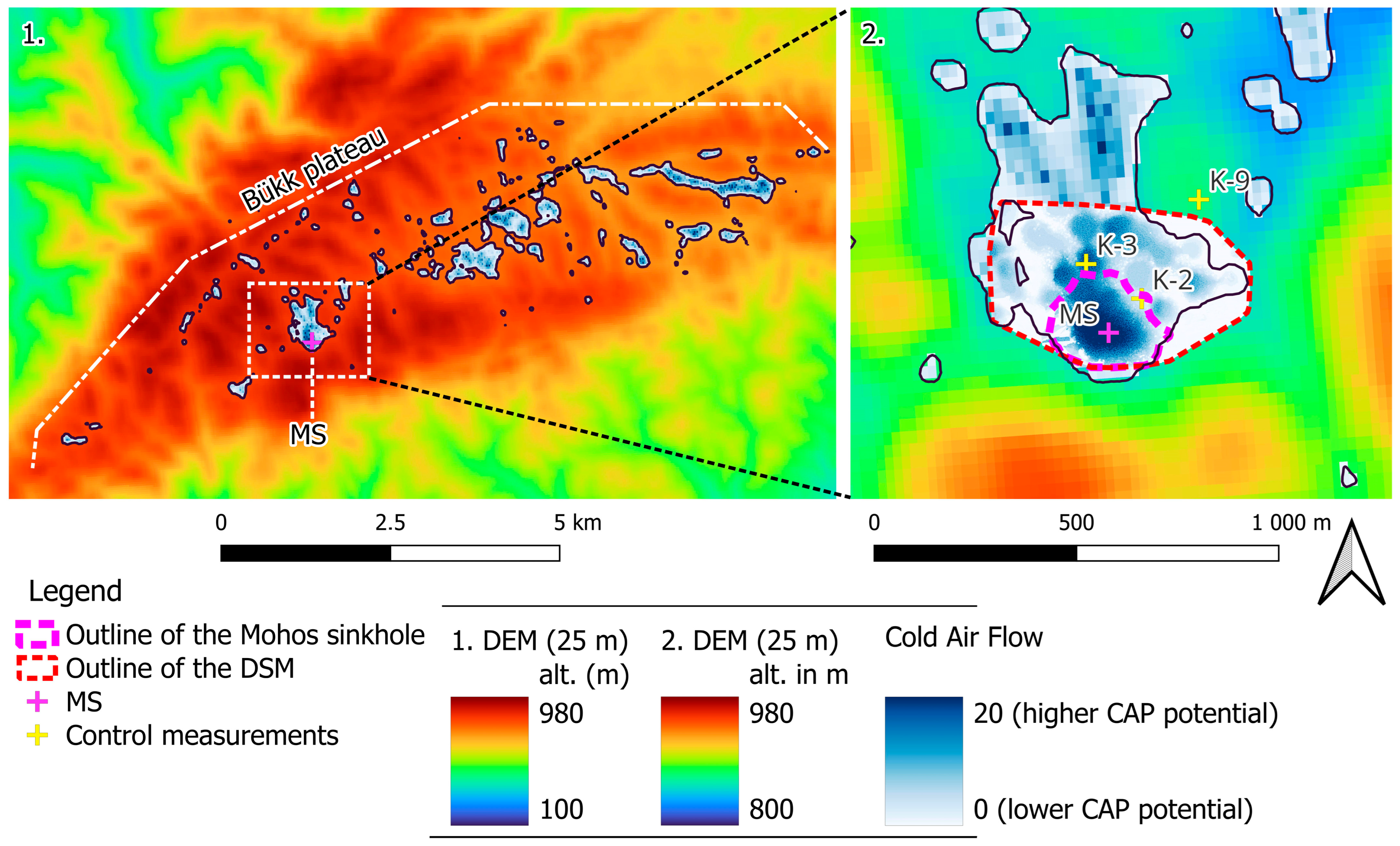




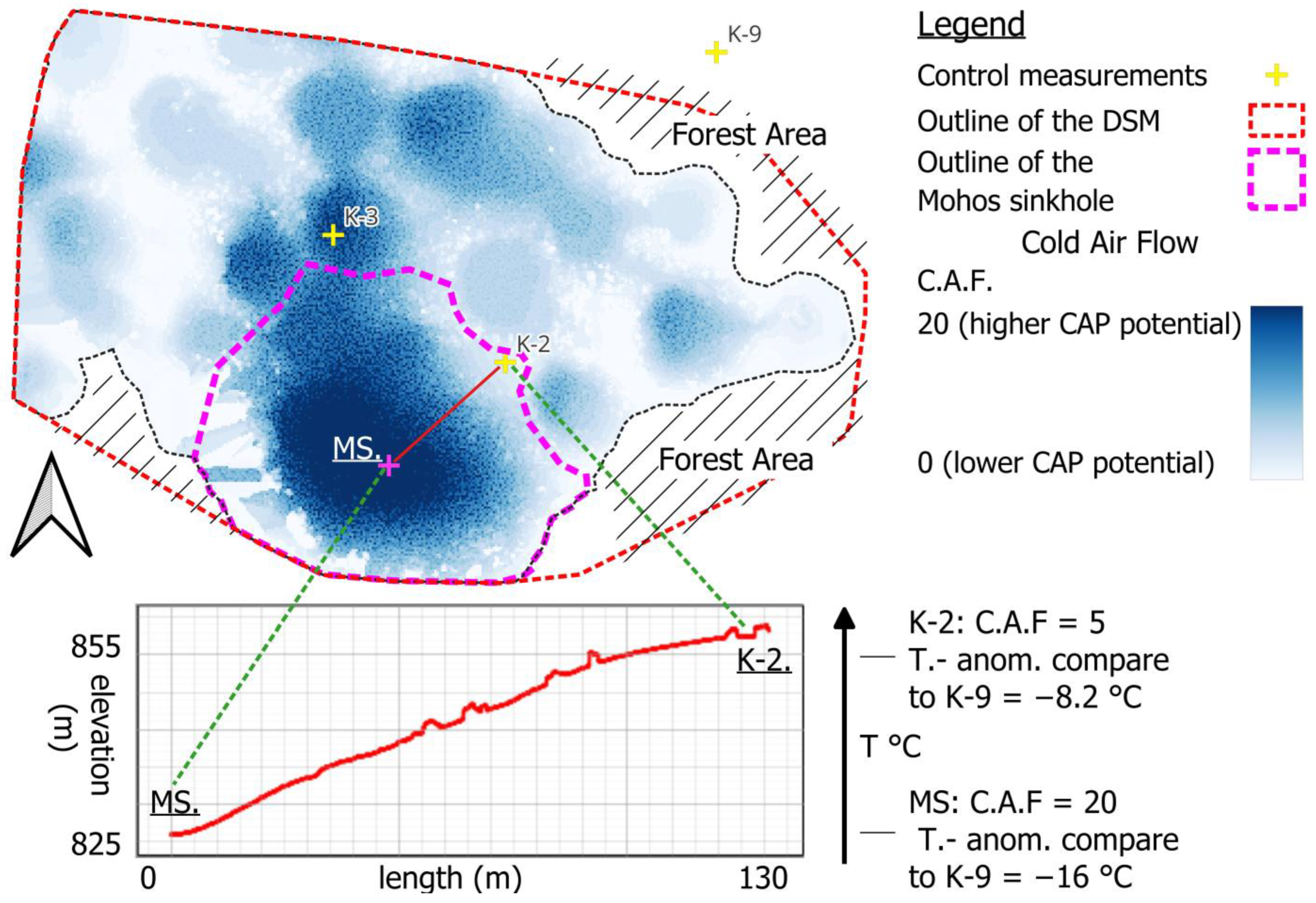
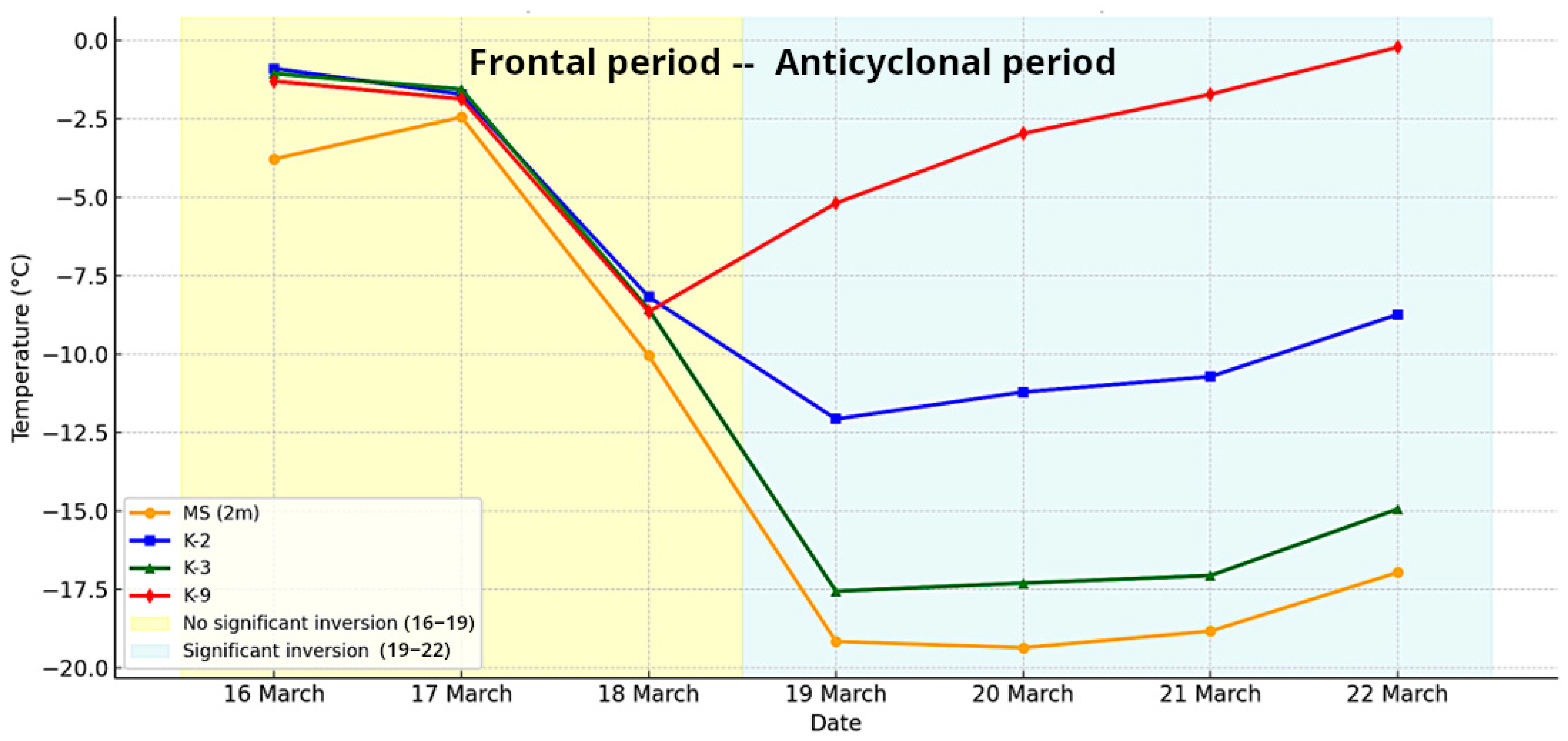

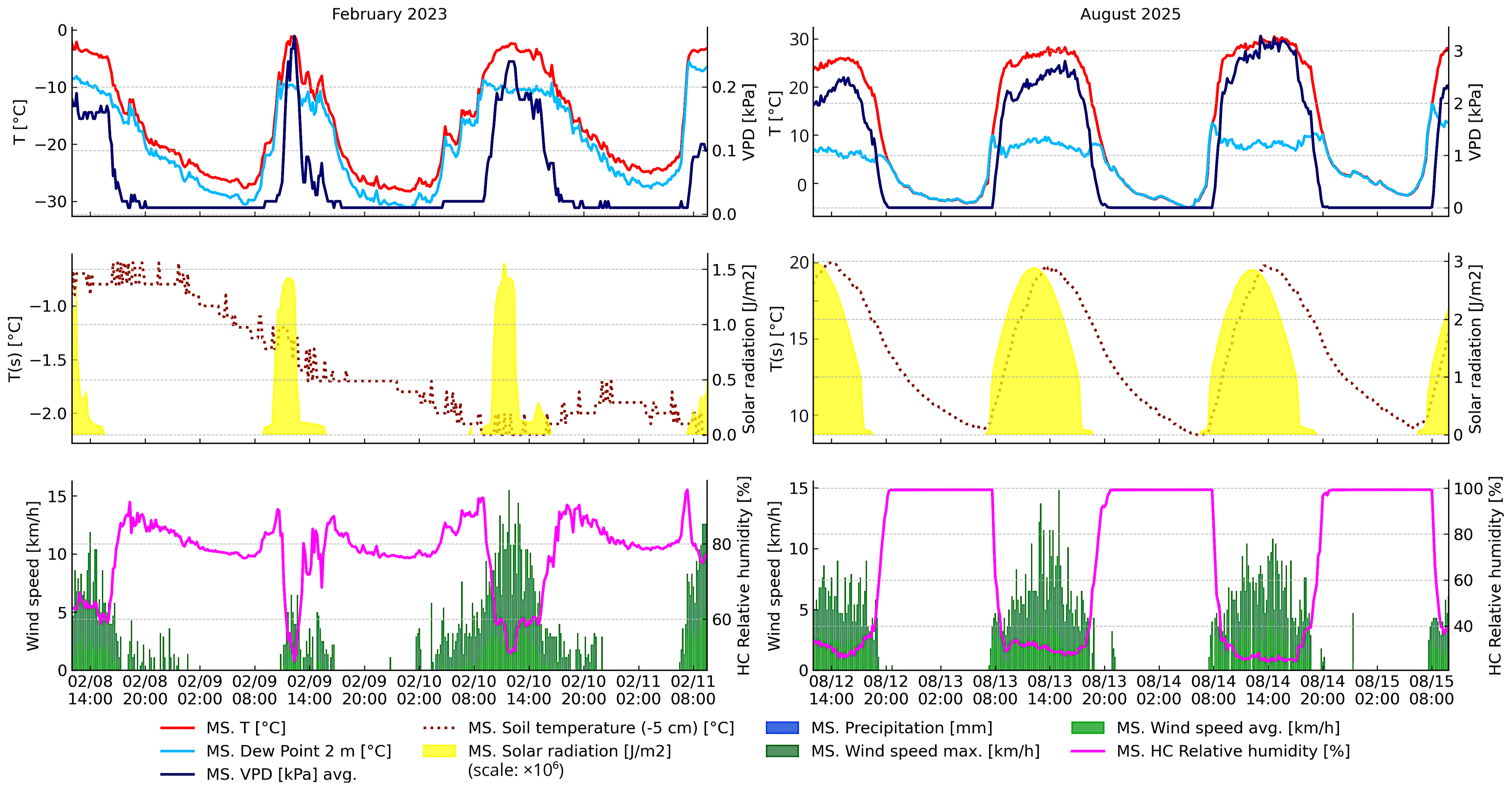
Disclaimer/Publisher’s Note: The statements, opinions and data contained in all publications are solely those of the individual author(s) and contributor(s) and not of MDPI and/or the editor(s). MDPI and/or the editor(s) disclaim responsibility for any injury to people or property resulting from any ideas, methods, instructions or products referred to in the content. |
© 2025 by the authors. Licensee MDPI, Basel, Switzerland. This article is an open access article distributed under the terms and conditions of the Creative Commons Attribution (CC BY) license (https://creativecommons.org/licenses/by/4.0/).
Share and Cite
Dobos, A.; Farkas, R.; Dobos, E. Terrain-Based High-Resolution Microclimate Modeling for Cold-Air-Pool-Induced Frost Risk Assessment in Karst Depressions. Climate 2025, 13, 205. https://doi.org/10.3390/cli13100205
Dobos A, Farkas R, Dobos E. Terrain-Based High-Resolution Microclimate Modeling for Cold-Air-Pool-Induced Frost Risk Assessment in Karst Depressions. Climate. 2025; 13(10):205. https://doi.org/10.3390/cli13100205
Chicago/Turabian StyleDobos, András, Réka Farkas, and Endre Dobos. 2025. "Terrain-Based High-Resolution Microclimate Modeling for Cold-Air-Pool-Induced Frost Risk Assessment in Karst Depressions" Climate 13, no. 10: 205. https://doi.org/10.3390/cli13100205
APA StyleDobos, A., Farkas, R., & Dobos, E. (2025). Terrain-Based High-Resolution Microclimate Modeling for Cold-Air-Pool-Induced Frost Risk Assessment in Karst Depressions. Climate, 13(10), 205. https://doi.org/10.3390/cli13100205





